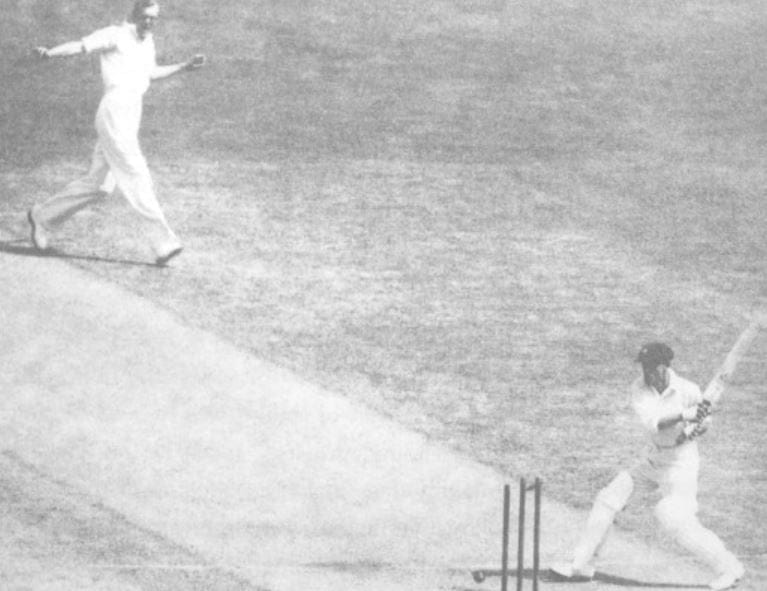Image: “The famous duck: Bradman bowled by Bowes at the MCG, in front of a world record crowd assembled to see Bradman defeat Bodyline” Newspaper photograph taken on 30 December 1932 at the Melbourne Cricket Ground. Copyright expired (ie. it is pre-1955). It appears on page 151 of “Bodyline Autopsy” by David Frith (2002) published by ABC Books ISBN 0 7333 1321-3.
Nicholas Hogg, of this parish, has written an entertaining article , arguing, perhaps not wholly seriously, that today’s cricketers are “better”, whatever that means, than their predecessors.
The nub of his argument is contained in a single paragraph: “Beam a modern batting hero into the 1930s and I reckon he’d cope. Drop Don Bradman into a T20 and he’d probably lose you the game.”
Hmm…discuss? The immediate Bradman comparison seems a little facile. Isn’t it similar to saying that Shakespeare would struggle with social media. ( “To be or, like, not to be…”). Batting, like so much sport, is very much a test of the mind , in particular the ability to make the right decision in the shortest possible time. This is as true of Twenty20 as of a timeless Test. It is difficult to believe that Bradman, once apprised of the rules and given some time to adjust, would not have prospered at the former. Look at Joe Root, a classical batsman, arguably the best in the world at the moment. His wonderful innings against South Africa at Mumbai was beautifully crafted, a conventional innings ideally constructed for the shortest format. Bradman would surely have been capable of something similar.
It is interesting that Hogg picked the 1930s for his comparison. Of course Bradman played most of his cricket then. It was, in general, an era when bat dominated ball, rather like today. Not many of cricket’s great bowlers, apart from the Australian leg spinners Bill O ‘ Reilly and Clarrie Grimmett, flourished in the 1930s. One exception was Harold Larwood, one of the greatest of all fast bowlers, who reduced Bradman’s average to a paltry 56 during the Bodyline series but was then put out to grass by cricket’s Establishment. There is no one like him – Dale Steyn in his pomp aside- or Grimmett or O’ Reilly, now.
You would not expect every star of the 1930s to walk into the modern game and prosper. Phil Mead, the first-class game’s fourth highest run sscorer, whose varicose veins made him something of a liability in the field , might have struggled , certainly in Twenty20 ( though he was no slouch with the bat ). Of course not everybody can do everything, even in the same era. Root, like his closest rivals , Steve Smith , A B de Villiers and Virat Kohli , excels in all three formats but this is unusual . England’s Twenty20 openers, Alex Hales and Jason Roy, exemplify the inventiveness and power that so impress Hogg. It is difficult, though , to imagine them replicating that success as Test openers, even today , let alone against Lindwall and Miller or Lillee and Thomson, without helmets. That is not to belittle their achievements, any more than saying that Len Hutton ( like Alastair Cook ) might struggle in Twenty20 is to detract from his status as one of the greatest batsmen of all time. The best Test opener of today is David Warner who stepped into Test cricket straight from Twenty20
Modern cricketers are highly athletic – fielding is astonishing and one thing The Don – a great outfielder himself , like the young Jack Hobbs – would have to adapt to as a batsman. In the old days it was not uncommon for fielders to stand and watch as the ball sped to the boundary. Wicket keeping is a bit different. An international keeper these days has to be worth his place as a batsman. If he can hold his own, as it were, as a stumper, that is a bonus. The time has passed where a player is picked solely for his ability with the gloves, and something has been lost.
Batsmen have always been inventive; for Tillikeratne Dilshan, read K S Ranjitsinjhi , a century earlier. Technique develops, equipment improves , rules change – usually in favour of batsmen: this is accentuated in limited overs cricket – a batsman can play through an innings but a bowler can bowl only so many overs: why? All these things change over the years. Genius, though, has no constraints. Bradman, Gaefield Sobers, Wasim Akram, Shane Warne – they would have flourished in any era and in any format.
” Everything worth doing is worth doing quickly” is a modern advertising mantra as absurd – almost daft- as it is emblematic of our age. And it tells us everything we need to know about Twenty20. Yet the game is still recognizably the one played by Bradman and Hutton. That is cricket’s strength. As I said earlier, mental strength is the thing. We saw that in a small way in that game in Mumbai. England were set a challenging 230 and eased their way to 229 in nineteen overs. Could they get the winning run in the final over? Panic almost denied them.
The past, as L P Hartley famously told us, is like a foreign country: they do things differently there. That is the point. Not better. Not worse. Just differently.
Bill Ricquier, 22/3/2016
This article was published in ESPN Cricinfo: http://www.espncricinfo.com/blogs/content/story/988765.html




